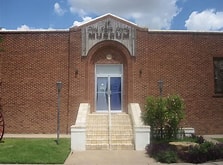Deaf Smith County Historical Museum
 From Conservapedia
From Conservapedia 
The Deaf Smith County Historical Museum, located in Hereford in Deaf Smith County, Texas, seeks to preserve the West Texas pioneer heritage with a collection of indoor and outdoor exhibits. The county is named for Erastus "Deaf" Smith (1787-1837), a famous scout during the Texas Revolution.
The museum was organized in 1967 by the Deaf Smith County Historical Society. It is located north of the county courthouse at 400 Sampson Street in a red brick former Roman Catholic school building, listed as an "Official Texas Historical Site."[1] The museum promotes the theme of "How Our Pioneers Lived, Worked and Played." School or group tours are available by appointment. An annual Christmas open house features seasonal entertainment, special activities, and holiday refreshments. Other events are hosted to commemorate special occasions.[2]
Museum exhibits[edit]
The indoor exhibits on the first floor include recreations of a general store, which became a social center in the 19th century as well as the source of needed goods. A non-denominational chapel includes artifacts, including stained-glass windows, from the first churches built in the county. It is sometimes used for small weddings. There is an early-day kitchen with a cast-iron cook stove and a primitive ice box. A restored bedroom depicts furniture purchased from local stores in the early 1900s, including a washstand, dresser, and bed. A parlor shows a later period as Hereford had prospered to allow citizens to own nice furniture, a pump organ, and other items for family entertainment.[3]
The museum has a display of arrow points, pottery, tools and other Native Americans artifacts donated from a private collection. There is a one-room school; a hand-carved three-ring circus, and a women's clothing shop. Also highlighted are items from an Italian prisoner of war camp during World War II near Hereford.[3] There are paintings, including portraits of Deaf Smith, Francisco Vasquez de Coronado and Ranald S. Mackenzie (1840-1889) and scenes of a 19th-century homestead and a cattle drive.[3]
The outside exhibits include a half-dugout, a first residence for many settlers on the Great Plains, where the absence of forests and lack of available stone required digging into the ground. An Atchison, Topeka, and Santa Fe Railway caboose, a wooden windmill, early jail cells, farm implements. A wagon barn with a chuckwagon, originally developed by Charles Goodnight, is on display outside the museum.[1][3]
E. B. Black House[edit]
The historical society also exhibits the E. B. Black House, a Victorian-style residence at 508 West Third Street in Hereford. It was built in 1909 by Mr. and Mrs. E. B. Black, ranchers who also owned a furniture company. Jim Black (1896-1976), the oldest son of the E. B. Blacks, and his wife, Prudia C. Black (1896-1978) lived in the house until Jim's death. Mrs. Black then donated the house to the historical society. The house has been renovated, and a flower garden and gazebo were added. The Texas Historical Commission has designated the house a state landmark. It is also entered in the National Register of Historic Places.[4]
References[edit]
- ↑ 1.0 1.1 "Hereford, Texas," Texas State Travel Guide, 2010, p. 127.
- ↑ About the Deaf Smith County Museum. deafsmithcountymuseum.org. Retrieved on January 23, 2020.
- ↑ 3.0 3.1 3.2 3.3 Exhibits at the Deaf Smith County Historical Museum. deafsmithcountymuseum.org. Retrieved on January 23, 2020.
- ↑ E.B. Black Historical House. deafsmithcountymuseum.org. Retrieved on January 23, 2020.
Categories: [Texas] [Museums] [History]
↧ Download as ZWI file | Last modified: 02/10/2023 22:02:59 | 7 views
☰ Source: https://www.conservapedia.com/Deaf_Smith_County_Historical_Museum | License: CC BY-SA 3.0
 ZWI signed:
ZWI signed: KSF
KSF